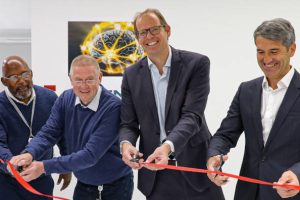
“These unpaired spins change the rules for what happens when a photon is absorbed and electrons are moved up to a higher energy level. We’ve been working with systems where there is one net spin, which makes them good for light emission and making LEDs,” said Cavendish Laboratory researcher Sebastian Gorgon, adding: “These new materials hold great promise for completely new applications, since we’ve been able to remove the need for ultra-cold temperatures.”
Un-paired electrons are found in molecules called radicals, which are normally very reactive because of the un-bound electron, but can be stabilised by careful molecular design.
The research team designed such radical molecules that are also both light-sensitive and light-emitting, and bridged them together with the hydrocarbon anthracene.
 If the radical absorbs a photon, said the university, excitation spreads into the anthracene, giving three electrons the same spin, and an electron on the molecule on the other side of the bridge can join in to make it four with the same spin.
If the radical absorbs a photon, said the university, excitation spreads into the anthracene, giving three electrons the same spin, and an electron on the molecule on the other side of the bridge can join in to make it four with the same spin.
“In this example, we can switch on the interaction between two electrons on opposite ends of the molecule by aligning electron spins on the bridge absorbing a photon of light,” said Gorgon. “After relaxing back, the distant electrons remember they were together even after the bridge is gone. Absorbing a photon is like turning a switch on.”
“The fact that we can start to control these quantum objects by reliably coupling spins at room temperature could open up far more flexibility in the world of quantum technologies,” he continued. “There’s a huge potential here to go in lots of new directions.”
“Knowing what electron spins are doing, let alone controlling them, is not straightforward, especially at room temperature,” said team co-leader and Cambridge Fellow Professor Richard Friend. “But if we can control the spins, we can build some interesting and useful quantum objects.”
The University of Cambridge worked with Jilin University, University of Oxford, University of Namur, Donostia International Physics Centre, University of Manchester, University of Würzburg, University of Mons and Swansea University.
In the collaboration, the materials were made in China, experiments were done in Cambridge, Oxford and Germany, and theory work was done in Belgium and Spain.
Support came from the European Research Council, the European Union, the UK EPSRC and the Royal Society.
‘Reversible spin-optical interface in luminescent organic radicals‘ describes the research in Nature – the full paper can be read without payment.
Illustration provided by the University of Cambridge
 Electronics Weekly Electronics Design & Components Tech News
Electronics Weekly Electronics Design & Components Tech News


